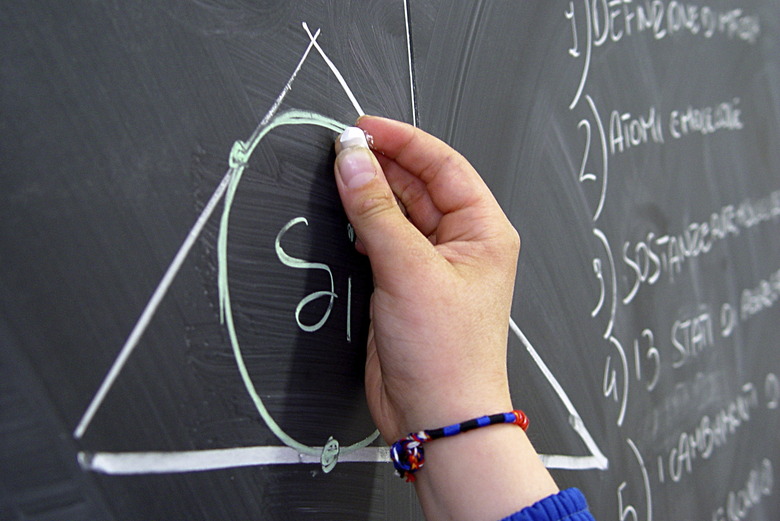How To Calculate The Area Of A Shaded Region
The grass in a rectangular yard needs to be fertilized, and there is a circular swimming pool at one end of the yard. The amount of fertilizer you need to purchase is based on the area needing to be fertilized. So, what area of the yard needs to be fertilized? This question can be answered by learning to calculate the area of a shaded region. In this type of problem, the area of a small shape is subtracted from the area of a larger shape that surrounds it. The area outside the small shape is shaded to indicate the area of interest.
Determine what basic shapes are represented in the problem. Each shape must have its own area equation. In the example mentioned, the yard is a rectangle, and the swimming pool is a circle. Often, these problems and situations will deal with polygons or circles. Many polygons have well defined and simple area formulas, but it is possible with more complex composite figures and areas we might need to break it down into more regular polygons and shapes.
The Step-by-Step Process
The Step-by-Step Process
Calculate the area of both shapes. With our example yard, the area of a rectangle is determined by multiplying its length times its width. The area of a circle is pi (i.e. 3.14) times the square of the radius.
\(A_\text{rectangle} = l \times w\)
\(\ \text{}\)
\(A_\text{circle} = \pi r^2\)
Find the area of the shaded region by subtracting the area of the small shape from the area of the larger shape. The result is the area of only the shaded region, instead of the entire large shape. In this example, the area of the circle is subtracted from the area of the larger rectangle. This will return the area of the shaded part.
Check the units of the final answer to make sure they are square units, indicating the correct units for area. That is square meters (m2), square feet (ft2), square yards (yd2), or many other units of area measure.
TL;DR (Too Long; Didn't Read)
Problems that ask for the area of shaded regions can include any combination of basic shapes, such as circles within triangles, triangles within squares, or squares within rectangles.
Sometimes either or both of the shapes represented are too complicated to use basic area equations, such as an L-shape. In this case, break the shape down even further into recognizable shapes. For example, an L-shape could be broken down into two rectangles. Then add the two areas together to get the total area of the shape.
Common Area Formulae
Common Area Formulae
There are many common polygons and shapes that we might encounter in a high school math class and beyond. Some of the most common are triangles, rectangles, circles, and trapezoids. Many other more complicated shapes like hexagons or pentagons can be constructed from a combination of these shapes (e.g. a regular hexagon is six triangles put together). Other shapes like parallelograms are more general. They can have a formula for area, but sometimes it is easier to find the shapes we already recognize within them.
References
Area of a Triangle
The area of a triangle is simple one-half times base times height.
\(A_\text{triangle} = \frac{1}{2} \times \text{base} \times \text{height}\)
With a right triangle, this will simply be the two smaller side lengths (the legs) multiplied together, but with other triangles we need to be careful to find the height that is perpendicular to the base we are using. See this article for further reference on how to calculate the area of a triangle. This method works for a scalene, isosceles, or equilateral triangle.
Area of a Rectangle
A rectangle consists of four straight lines where opposite sides are parallel, and all sides form 90 degree angles. This makes the calculation for area very straight forward, it is just base time height, or length times width:
\(A_\text{rectangle} = \frac{1}{2}\times \text{length} \times \text{width}\)
It is also helpful to realize that as a square is a special type of rectangle, it uses the same formula to find the area of a square.
Area of a Circle
A circle has a one size fits all formula to find the area:
\(A_\text{circle} = \pi \text{radius}^2\)
The key to using this formula well is understanding the other measurements of a circle, and how to apply this area formula to sectors and pieces of a circle. The angles of a circle are often measured in degrees or radians, and we just need to know how to use these measurements as a ratio to find the area of a sector of a circle or a semicircle. This resource explains this process very well!
Cite This Article
MLA
Bush, Joshua. "How To Calculate The Area Of A Shaded Region" sciencing.com, https://www.sciencing.com/calculate-area-shaded-regions-2311589/. 22 April 2023.
APA
Bush, Joshua. (2023, April 22). How To Calculate The Area Of A Shaded Region. sciencing.com. Retrieved from https://www.sciencing.com/calculate-area-shaded-regions-2311589/
Chicago
Bush, Joshua. How To Calculate The Area Of A Shaded Region last modified April 22, 2023. https://www.sciencing.com/calculate-area-shaded-regions-2311589/
